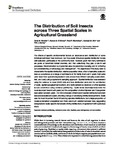The distribution of soil insects across three spatial scales in agricultural grassland
| dc.contributor.author | Benefer, CM | en |
| dc.contributor.author | D'ahmed, KS | en |
| dc.contributor.author | Blackshaw, RP | en |
| dc.contributor.author | Sint, HM | en |
| dc.contributor.author | Murray, PJ | en |
| dc.date.accessioned | 2016-06-23T12:17:03Z | |
| dc.date.available | 2016-06-23T12:17:03Z | |
| dc.date.issued | 2016-04-21 | en |
| dc.identifier.uri | http://hdl.handle.net/10026.1/4956 | |
| dc.description.abstract |
The effects of specific environmental factors on abundance and distribution of some individual soil insect taxa is known, but how scale influences spatial distribution is less well evaluated, particularly at the community level. However, given that many soil insects are pests or beneficial natural enemies, and that collectively they play a role in soil processes, this information is of potential value for predictive modeling and in furthering our understanding of soil ecology and management. The objectives of this study were to characterize the spatial distribution, relative population sizes, effect of sampling scale and taxa co-occurrence on a range of soil insects at the family level over 2 years. Soil cores were taken from agricultural grassland soils across three different sampling scales (farm, field, and core) using a systematic sampling approach. Spatial distribution was assessed using the variance-to-mean (VMR) ratio and taxa distribution plots and the contribution of scale, spatial (geographical location), and biotic (presence-absence of other species) factors determined using deviance partitioning. Tipulid larvae (leatherjackets) were the most abundant taxa in both years, but the composition of other Dipteran and Coleopteran taxa varied between years. The VMRs revealed differences in spatial distribution between taxa across scales and years, showing a range of underlying distributional patterns. Scale was the most important factor influencing species distributions, but a large proportion of deviance remained unexplained and there was much variation between taxa, suggesting biological and scale-specific factors are driving distributions, in agreement with a previous study. | en |
| dc.language.iso | en | en |
| dc.publisher | Frontiers | en |
| dc.subject | deviance partitioning | en |
| dc.subject | variance-to-mean ratio | en |
| dc.subject | Tipulidae | en |
| dc.subject | Pest | en |
| dc.subject | Belowground | en |
| dc.subject | Soil communities | en |
| dc.title | The distribution of soil insects across three spatial scales in agricultural grassland | en |
| dc.type | Journal Article | |
| plymouth.issue | 41 | en |
| plymouth.volume | 4 | en |
| plymouth.publication-status | Published | en |
| plymouth.journal | Frontiers in Ecology and Evolution | en |
| dc.identifier.doi | 10.3389/fevo.2016.00041 | en |
| plymouth.organisational-group | /Plymouth | |
| dcterms.dateAccepted | 2016-04-04 | en |
| dc.rights.embargoperiod | No embargo | en |
| rioxxterms.versionofrecord | 10.3389/fevo.2016.00041 | en |
| rioxxterms.licenseref.uri | http://www.rioxx.net/licenses/all-rights-reserved | en |
| rioxxterms.licenseref.startdate | 2016-04-21 | en |
| rioxxterms.type | Journal Article/Review | en |
| plymouth.oa-location | http://journal.frontiersin.org/article/10.3389/fevo.2016.00041/full | en |


